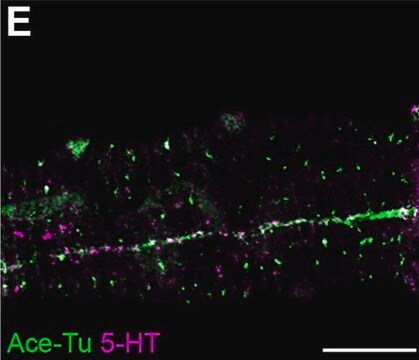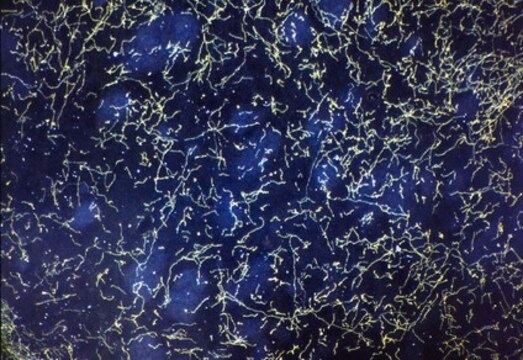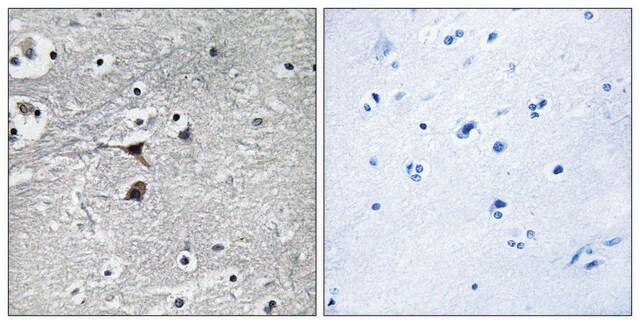AB125
Anti-Serotonin Antibody
serum, Chemicon®
Synonym(s):
5-HT
Sign Into View Organizational & Contract Pricing
All Photos(1)
About This Item
UNSPSC Code:
12352203
eCl@ss:
32160702
NACRES:
NA.41
Recommended Products
biological source
rabbit
Quality Level
antibody form
serum
antibody product type
primary antibodies
clone
polyclonal
species reactivity
rat
manufacturer/tradename
Chemicon®
technique(s)
immunohistochemistry: suitable
shipped in
dry ice
target post-translational modification
unmodified
Specificity
Serotonin (5-Hydroxytryptamine)
The cross-reactivities were determined using an ELISA test by competition experiments with the following compounds:
Compound Cross-reactivity
5-Hydroxytryptamine-G-PL 1
5-Methoxytryptamine-G-PL 1/25
Tryptamine-G-PL 1/60
5-Hydroxytryptophan-G-PL 1/175
5-Hydroxytryptamine 1/1150
Tryptophan-G-PL 1/3400
5-Methoxytryptophan-G-PL 1/19800
The antisera was also tested for specificity using the free-floating PAP technique on rat
raphe nuclei.
Abbreviations:
(G) Glutaraldehyde
(=) Non-reduced conjugate
(PL) Poly-lysine
The cross-reactivities were determined using an ELISA test by competition experiments with the following compounds:
Compound Cross-reactivity
5-Hydroxytryptamine-G-PL 1
5-Methoxytryptamine-G-PL 1/25
Tryptamine-G-PL 1/60
5-Hydroxytryptophan-G-PL 1/175
5-Hydroxytryptamine 1/1150
Tryptophan-G-PL 1/3400
5-Methoxytryptophan-G-PL 1/19800
The antisera was also tested for specificity using the free-floating PAP technique on rat
raphe nuclei.
Abbreviations:
(G) Glutaraldehyde
(=) Non-reduced conjugate
(PL) Poly-lysine
Immunogen
5-Hydroxytryptamine-glutaraldehyde-Poly-lysine
Application
Anti-Serotonin Antibody detects level of Serotonin & has been published & validated for use in IH.
Immunohistochemistry: 1:1,000-1:2,500 by ABC or enhanced detection. Glutaraldehyde fixation is required. Antibody will not react with non-glutaraldehyde treated tissues. Blocking should be with serum or BSA containing 0.1-0.2% triton X-100; remove all blocking an detergents during primary antibody incubation. Dilute only in PBS or TBS for best results. For fluorescent detection antibody dilution must be reduced, but it is not recommended because of glutaraldehyde autofluorescence.
Optimal working dilutions must be determined by the end user.
Optimal working dilutions must be determined by the end user.
Research Category
Neuroscience
Neuroscience
Research Sub Category
Neurotransmitters & Receptors
Neurotransmitters & Receptors
Physical form
Rabbit antiserum. Liquid with 0.05% sodium azide.
Storage and Stability
Maintain at -20°C in undiluted aliquots for up to 6 months after date of receipt. Avoid repeated freeze/thaw cycles.
Legal Information
CHEMICON is a registered trademark of Merck KGaA, Darmstadt, Germany
Disclaimer
Unless otherwise stated in our catalog or other company documentation accompanying the product(s), our products are intended for research use only and are not to be used for any other purpose, which includes but is not limited to, unauthorized commercial uses, in vitro diagnostic uses, ex vivo or in vivo therapeutic uses or any type of consumption or application to humans or animals.
Not finding the right product?
Try our Product Selector Tool.
Storage Class Code
10 - Combustible liquids
WGK
WGK 2
Flash Point(F)
Not applicable
Flash Point(C)
Not applicable
Certificates of Analysis (COA)
Search for Certificates of Analysis (COA) by entering the products Lot/Batch Number. Lot and Batch Numbers can be found on a product’s label following the words ‘Lot’ or ‘Batch’.
Already Own This Product?
Find documentation for the products that you have recently purchased in the Document Library.
Serotonin-like immunoreactivity in Merkel cells and their afferent neurons in touch domes from the hairy skin of rats.
K B English, Z Z Wang, N Stayner, L J Stensaas, H Martin, R P Tuckett
The Anatomical Record null
Z Z Wang et al.
Neuroscience, 47(2), 473-480 (1992-01-01)
The mammalian carotid body consists of preneural type I (glomus) cells synaptically coupled to afferent axon terminals and enveloped by type II (sustentacular) cells. Recent studies indicate the presence of multiple putative neurotransmitters in this arterial chemoreceptor organ. A double-labeling
Time-course gait analysis of hemiparkinsonian rats following 6-hydroxydopamine lesion.
Hsieh TH, Chen JJ, Chen LH, Chiang PT, Lee HY
Behavioural Brain Research null
The chemical code of porcine enteric neurons and the number of enteric glial cells are altered by dietary probiotics.
A di Giancamillo,F Vitari,G Bosi,G Savoini,C Domeneghini
Neurogastroenterology and Motility null
A new tumorsphere culture condition restores potentials of self-renewal and metastasis of primary neuroblastoma in a mouse neuroblastoma model.
Cao, D; Kishida, S; Huang, P; Mu, P; Tsubota, S; Mizuno, M; Kadomatsu, K
Testing null
Our team of scientists has experience in all areas of research including Life Science, Material Science, Chemical Synthesis, Chromatography, Analytical and many others.
Contact Technical Service








